-

新人教版高中英语选修2Unit 4 Journey Across a Vast Land教学设计
当孩子们由父母陪同时,他们才被允许进入这个运动场。3.过去分词(短语)作状语时的几种特殊情况(1)过去分词(短语)在句中作时间、条件、原因、让步状语时,相当于对应的时间、条件、原因及让步状语从句。Seen from the top of the mountain (=When it is seen from the top of the mountain), the whole town looks more beautiful.从山顶上看,整个城市看起来更美了。Given ten more minutes (=If we are given ten more minutes), we will finish the work perfectly.如果多给十分钟,我们会完美地完成这项工作。Greatly touched by his words (=Because she was greatly touched by his words), she was full of tears.由于被他的话深深地感动,她满眼泪花。Warned of the storm (=Though they were warned of the storm), the farmers were still working on the farm.尽管被警告了风暴的到来,但农民们仍在农场干活。(2)过去分词(短语)在句中作伴随、方式等状语时,可改为句子的并列谓语或改为并列分句。The teacher came into the room, followed by two students (=and was followed by two students).后面跟着两个学生,老师走进了房间。He spent the whole afternoon, accompanied by his mom(=and was accompanied by his mom).他由母亲陪着度过了一整个下午。

新人教版高中英语选修2Unit 1 Science and Scientists-Learning about Language教学设计
Step 7: complete the discourse according to the grammar rules.Cholera used to be one of the most 1.__________ (fear) diseases in the world. In the early 19th century, _2_________ an outbreak of cholera hit Europe, millions of people died. But neither its cause, 3__________ its cure was understood. A British doctor, John Snow, wanted to solve the problem and he knew that cholera would not be controlled _4_________ its cause was found. In general, there were two contradictory theories 5 __________ explained how cholera spread. The first suggested that bad air caused the disease. The second was that cholera was caused by an _6_________(infect) from germs in food or water. John Snow thought that the second theory was correct but he needed proof. So when another outbreak of cholera hit London in 1854, he began to investigate. Later, with all the evidence he _7_________ (gather), John Snow was able to announce that the pump water carried cholera germs. Therefore, he had the handle of the pump _8_________ (remove) so that it couldn't be used. Through his intervention,the disease was stopped in its tracks. What is more, John Snow found that some companies sold water from the River Thames that __9__________________ (pollute) by raw waste. The people who drank this water were much more likely _10_________ (get) cholera than those who drank pure or boiled water. Through John Snow's efforts, the _11_________ (threaten) of cholera around the world saw a substantial increase. Keys: 1.feared 2.when 3. nor 4.unless 5.that/which 6.infection 7.had gathered 8.removed 9.was polluted 10.to get 11. threat

新人教版高中英语选修2Unit 1 Science and Scientists-Reading and thinking教学设计
Step 5: After learning the text, discuss with your peers about the following questions:1.John Snow believed Idea 2 was right. How did he finally prove it?2. Do you think John Snow would have solved this problem without the map?3. Cholera is a 19th century disease. What disease do you think is similar to cholera today?SARS and Covid-19 because they are both deadly and fatally infectious, have an unknown cause and need serious public health care to solve them urgently.keys:1. John Snow finally proved his idea because he found an outbreak that was clearly related to cholera, collected information and was able to tie cases outside the area to the polluted water.2. No. The map helped John Snow organize his ideas. He was able to identify those households that had had many deaths and check their water-drinking habits. He identified those houses that had had no deaths and surveyed their drinking habits. The evidence clearly pointed to the polluted water being the cause.3. SARS and Covid-19 because they are both deadly and fatally infectious, have an unknown cause and need serious public health care to solve them urgently.Step 6: Consolidate what you have learned by filling in the blanks:John Snow was a well-known _1___ in London in the _2__ century. He wanted to find the _3_____ of cholera in order to help people ___4_____ it. In 1854 when a cholera __5__ London, he began to gather information. He ___6__ on a map ___7___ all the dead people had lived and he found that many people who had ___8____ (drink) the dirty water from the __9____ died. So he decided that the polluted water ___10____ cholera. He suggested that the ___11__ of all water supplies should be _12______ and new methods of dealing with ____13___ water be found. Finally, “King Cholera” was __14_____.Keys: 1. doctor 2. 19th 3.cause 4.infected with 5.hit 6.marked 7.where 8.drunk 9.pump 10.carried 11.source 12.examined 13.polluted 14.defeatedHomework: Retell the text after class and preview its language points

新人教版高中英语选修2Unit 1 Science and Scientists-Using langauge教学设计
This happens because the dish soap molecules have a strong negative charge, and the milk molecules have a strong positive charge. Like magnets, these molecules are attracted to each other, and so they appear to move around on the plate, taking the food coloring with them, making it look like the colors are quickly moving to escape from the soap.Listening text:? Judy: Oh, I'm so sorry that you were ill and couldn't come with us on our field trip. How are you feeling now? Better?? Bill: Much better, thanks. But how was it?? Judy: Wonderful! I especially liked an area of the museum called Light Games.it was really cool. They had a hall of mirrors where I could see myself reflected thousands of times!? Bill: A hall of mirrors can be a lot of fun. What else did they have?? Judy: Well, they had an experiment where we looked at a blue screen for a while, and then suddenly we could see tiny bright lights moving around on it. You'll never guess what those bright lights were!? Bill: Come on, tell me!? Judy: They were our own blood cells. For some reason, our eyes play tricks on us when we look at a blue screen, and we can see our own blood cells moving around like little lights! But there was another thing I liked better. I stood in front of a white light, and it cast different shadows of me in every color of the rainbow!? Bill: Oh, I wish I had been there. Tell me more!? Judy: Well, they had another area for sound. They had a giant piano keyboard that you could use your feet to play. But then, instead of playing the sounds of a piano, it played the voices of classical singers! Then they had a giant dish, and when you spoke into it, it reflected the sound back and made it louder. You could use it to speak in a whisper to someone 17 meters away.? Bill: It all sounds so cool. I wish I could have gone with you? Judy: I know, but we can go together this weekend. I'd love to go there again!? Bill: That sounds like a great idea!

新人教版高中英语选修2Unit 3 Food and Culture-Discovering useful structures教学设计
The newspaper reported more than 100 people had been killed in the thunderstorm.报纸报道说有一百多人在暴风雨中丧生。(2)before、when、by the time、until、after、once等引导的时间状语从句的谓语是一般过去时,以及by、before后面接过去的时间时,主句动作发生在从句的动作或过去的时间之前且表示被动时,要用过去完成时的被动语态。By the time my brother was 10, he had been sent to Italy.我弟弟10岁前就已经被送到意大利了。Tons of rice had been produced by the end of last month. 到上月底已生产了好几吨大米。(3) It was the first/second/last ... time that ...句中that引导的定语从句中,主语与谓语构成被动关系时,要用过去完成时的被动语态。It was the first time that I had seen the night fact to face in one and a half years. 这是我一年半以来第一次亲眼目睹夜晚的景色。(4)在虚拟语气中,条件句表示与过去事实相反,且主语与谓语构成被动关系时,要用过去完成时的被动语态。If I had been instructed by him earlier, I would have finished the task.如果我早一点得到他的指示,我早就完成这项任务了。If I had hurried, I wouldn't have missed the train.如果我快点的话,我就不会误了火车。If you had been at the party, you would have met him. 如果你去了晚会,你就会见到他的。

新人教版高中英语选修2Unit 3 Food and Culture-Reading and thinking教学设计
The discourse explores the link between food and culture from a foreign’s perspective and it records some authentic Chinese food and illustrates the cultural meaning, gerography features and historic tradition that the food reflects. It is aimed to lead students to understand and think about the connection between food and culture. While teaching, the teacher should instruct students to find out the writing order and the writer’s experieces and feelings towards Chinese food and culture.1.Guide the students to read the text, sort out the information and dig out the topic.2.Understand the cultural connotation, regional characteristics and historical tradition of Chinese cuisine3.Understand and explore the relationship between food and people's personality4.Guide the students to use the cohesive words in the text5.Lead students to accurately grasp the real meaning of the information and improve the overall understanding ability by understanding the implied meaning behind the text.1. Enable the Ss to understand the structure and the writing style of the passage well.2. Lead the Ss to understand and think further about the connection between food and geography and local character traits.Step1: Prediction before reading. Before you read, look at the title, and the picture. What do you think this article is about?keys:It is about various culture and cuisine about a place or some countries.
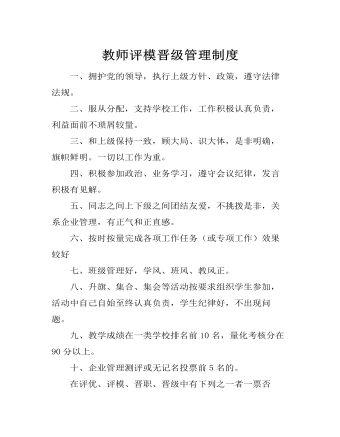
教师评模晋级管理制度
二、服从分配,支持学校工作,工作积极认真负责,利益面前不琐屑较量。 三、和上级保持一致,顾大局、识大体,是非明确,旗帜鲜明。一切以工作为重。 四、积极参加政治、业务学习,遵守会议纪律,发言积极有见解。 五、同志之间上下级之间团结友爱,不挑拨是非,关系企业管理,有正气和正直感。
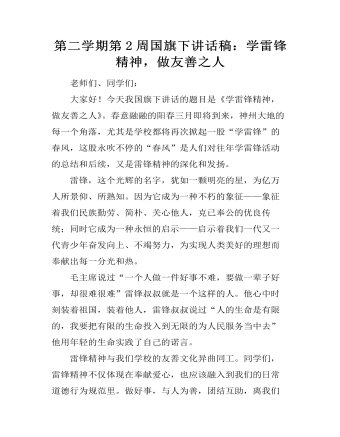
第二学期第2周国旗下讲话稿:学雷锋精神,做友善之人
老师们、同学们:大家好!今天我国旗下讲话的题目是《学雷锋精神,做友善之人》。春意融融的阳春三月即将到来,神州大地的每一个角落,尤其是学校都将再次掀起一股“学雷锋”的春风,这股永吹不停的“春风”是人们对往年学雷锋活动的总结和后续,又是雷锋精神的深化和发扬。雷锋,这个光辉的名字,犹如一颗明亮的星,为亿万人所景仰、所熟知。因为它成为一种不朽的象征——象征着我们民族勤劳、简朴、关心他人,克已奉公的优良传统;同时它成为一种永恒的启示——启示着我们一代又一代青少年奋发向上、不竭努力,为实现人类美好的理想而奉献出每一分光和热。毛主席说过“一个人做一件好事不难,要做一辈子好事,却很难很难”雷锋叔叔就是一个这样的人。他心中时刻装着祖国,装着他人,雷锋叔叔说过“人的生命是有限的,我要把有限的生命投入到无限的为人民服务当中去”他用年轻的生命实践了自己的诺言。
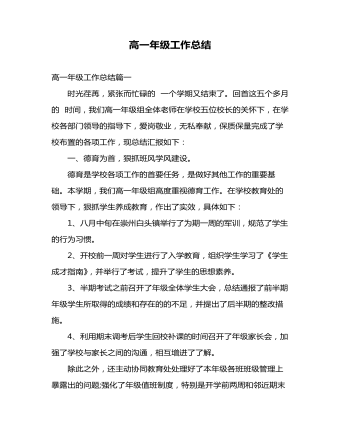
高一年级工作总结
重视与家长、社会的联系,构建比较完整的德育教育网络: 本期来,通过周会课、法制与心理健康教育课,对学生进行了针对性的思想教育。年级组、各班根据学生实际情况,通过家访、电话联系等形式,加强教师与家长、学校与家庭、社会的联系,沟通了学校教育和家庭教育。
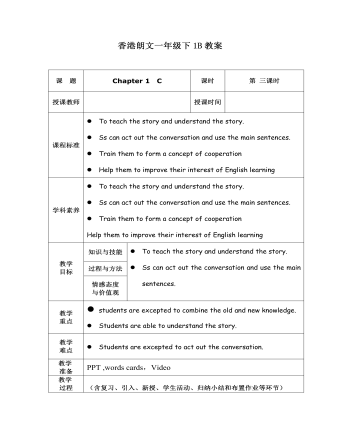
一年级朗文1B Chapter 1 C
l Toteach the story and understand the story.l Ss can act out the conversation anduse the main sentences.l Train them to form a concept ofcooperation Help them to improve their interest of Englishlearning
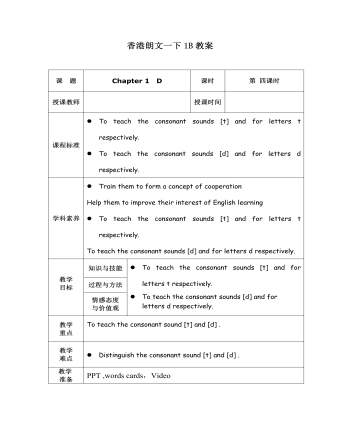
一年级朗文1A Chapter 1 D
l To teach the consonant sounds [t]and for letters t respectively.To teach the consonant sounds [d] and for letters d respectively.
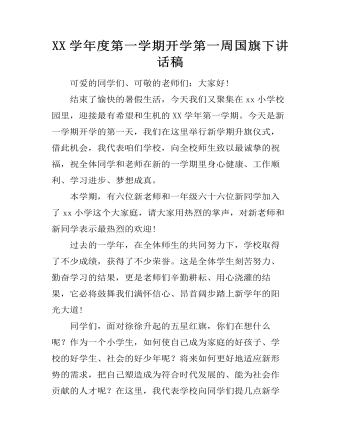
XX学年度第一学期开学第一周国旗下讲话稿
可爱的同学们、可敬的老师们:大家好! 结束了愉快的暑假生活,今天我们又聚集在xx小学校园里,迎接最有希望和生机的XX学年第一学期。今天是新一学期开学的第一天,我们在这里举行新学期升旗仪式,借此机会,我代表咱们学校,向全校师生致以最诚挚的祝福,祝全体同学和老师在新的一学期里身心健康、工作顺利、学习进步、梦想成真。 本学期,有六位新老师和一年级六十六位新同学加入了xx小学这个大家庭,请大家用热烈的掌声,对新老师和新同学表示最热烈的欢迎! 过去的一学年,在全体师生的共同努力下,学校取得了不少成绩,获得了不少荣誉。这是全体学生刻苦努力、勤奋学习的结果,更是老师们辛勤耕耘、用心浇灌的结果,它必将鼓舞我们满怀信心、昂首阔步踏上新学年的阳光大道! 同学们,面对徐徐升起的五星红旗,你们在想什么呢?作为一个小学生,如何使自己成为家庭的好孩子、学校的好学生、社会的好少年呢?将来如何更好地适应新形势的需求,把自己塑造成为符合时代发展的、能为社会作贡献的人才呢?
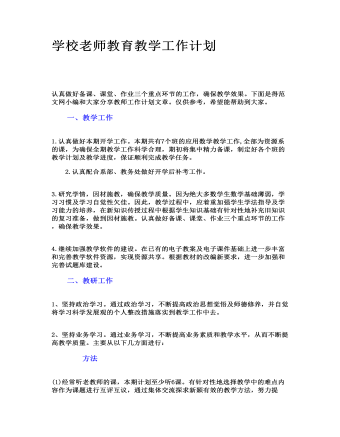
学校老师教育教学工作计划
1.认真做好本期开学工作。本期共有7个班的应用数学教学工作,全部为资源系的课,为确保全期教学工作科学合理,期初将集中精力备课,制定好各个班的教学计划及教学进度,保证顺利完成教学任务。 2.认真配合系部、教务处做好开学后补考工作。 3.研究学情,因材施教,确保教学质量。因为绝大多数学生数学基础薄弱,学习习惯及学习自觉性欠佳。因此,教学过程中,应着重加强学生学法指导及学习能力的培养,在新知识传授过程中根据学生知识基础有针对性地补充旧知识的复习准备,做到因材施教。认真做好备课、课堂、作业三个重点环节的工作,确保教学效果。

学校音乐教学教师心得体会多篇
一、 创设情境,激发学生学音乐的兴趣。 对于低年级同学来说,他们好动、注意力极易分散,但我抓住小同学爱听故事,善表现的特点,我采取讲故事引入课文内容,学会歌唱后,再指导他们根据词中内容来表演。课堂上,让学生上台演唱,培养他们的参与、实践能力,学生情绪高涨,使音乐课上得更加生动活跃。这时同学们的热情高涨,慢慢喜欢上音乐课。这样,每次上音乐课他们都会有一种期待,当然我也会不失时机地将教学音乐基本知识、节奏、歌曲处理(比如以什么情绪来唱好他)等讲授给学生,在一定程度上和学生取得配合,收到了一些效果,教了不少儿童歌曲,为丰富儿童的音乐世界起到了一定的作用。通过丰富多彩的音乐教学形式,激发学生学习音乐的兴趣和爱好,活跃空气,在紧张的文化课学习之余可调节情绪,有利于其他课的学习。
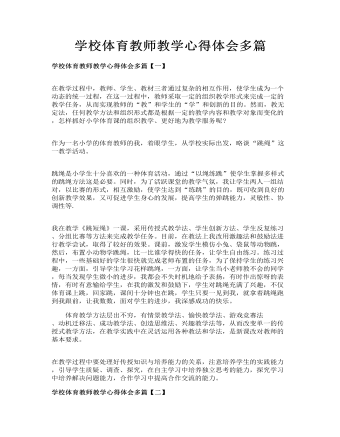
学校体育教师教学心得体会多篇
我在教学《跳短绳》一课,采用传授式教学法、学生创新方法、学生反复练习、分组比赛等方法来完成教学任务。目前,在教法上我改用激趣法和鼓励法进行教学尝试,取得了较好的效果。课前,激发学生模仿小兔、袋鼠等动物跳,然后,布置小动物学跳绳,比一比谁学得快的任务,让学生自由练习。练习过程中,一些基础好的学生很快就完成老师布置的任务,为了保持学生的练习兴趣,一方面,引导学生学习花样跳绳,一方面,让学生当小老师教不会的同学,每当发现学生微小的进步,我都会不失时机地给予表扬,有时作出惊呀的表情,有时有意输给学生,在我的激发和鼓励下,学生对跳绳充满了兴趣,不仅体育课上跳,回家跳,课间十分钟也在跳,学生只要一见到我,就拿着跳绳跑到我跟前,让我数数,面对学生的进步,我深感成功的快乐。
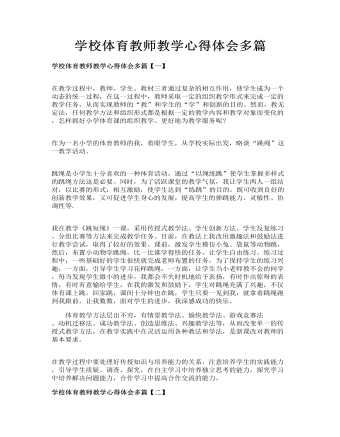
学校体育教师教学心得体会多篇
我在教学《跳短绳》一课,采用传授式教学法、学生创新方法、学生反复练习、分组比赛等方法来完成教学任务。目前,在教法上我改用激趣法和鼓励法进行教学尝试,取得了较好的效果。课前,激发学生模仿小兔、袋鼠等动物跳,然后,布置小动物学跳绳,比一比谁学得快的任务,让学生自由练习。练习过程中,一些基础好的学生很快就完成老师布置的任务,为了保持学生的练习兴趣,一方面,引导学生学习花样跳绳,一方面,让学生当小老师教不会的同学,每当发现学生微小的进步,我都会不失时机地给予表扬,有时作出惊呀的表情,有时有意输给学生,在我的激发和鼓励下,学生对跳绳充满了兴趣,不仅体育课上跳,回家跳,课间十分钟也在跳,学生只要一见到我,就拿着跳绳跑到我跟前,让我数数,面对学生的进步,我深感成功的快乐。
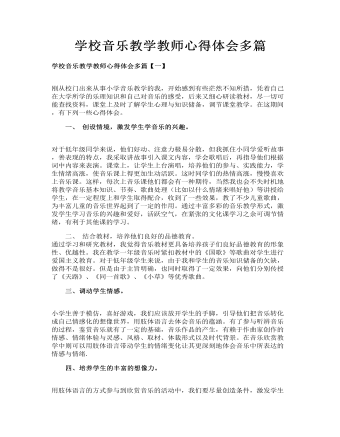
学校音乐教学教师心得体会多篇
一、 创设情境,激发学生学音乐的兴趣。 对于低年级同学来说,他们好动、注意力极易分散,但我抓住小同学爱听故事,善表现的特点,我采取讲故事引入课文内容,学会歌唱后,再指导他们根据词中内容来表演。课堂上,让学生上台演唱,培养他们的参与、实践能力,学生情绪高涨,使音乐课上得更加生动活跃。这时同学们的热情高涨,慢慢喜欢上音乐课。这样,每次上音乐课他们都会有一种期待,当然我也会不失时机地将教学音乐基本知识、节奏、歌曲处理(比如以什么情绪来唱好他)等讲授给学生,在一定程度上和学生取得配合,收到了一些效果,教了不少儿童歌曲,为丰富儿童的音乐世界起到了一定的作用。通过丰富多彩的音乐教学形式,激发学生学习音乐的兴趣和爱好,活跃空气,在紧张的文化课学习之余可调节情绪,有利于其他课的学习。

小学美术冀美版四年级下册《11绘画日记》说课稿
2、教学目的:根据《美术新课程标准》的精神和教材要求,结合四年级学生特点,本着激发学生学习兴趣,发展学生的想象力,培养学生的创造能力和动手实践能力,我确定本节课的教学目标为:①知识与技能:了解绘画日记的结构特点,并能应用到实际生活当中。②过程与方法:通过声音引发的“语、形、色”来描画记忆,完成日记的内容。③情感、态度、价值观:激发学生的形象思维,使学生认识生活中的真、善、美,提高学生的整体素质。

人音版小学音乐三年级下册嘀哩嘀哩说课稿
艺术课程作为一门新课程,是在已有的音乐、美术分科基础上构建的一门新课程,从传统的分科教学转变为多门艺术学科的沟通和融合。本课是从音乐切入的艺术课,让学生在欣赏、节奏、歌唱、表演等一系列音乐活动中感受音乐,学习音乐,表现音乐。让孩子们在歌唱描述春天的歌曲中体验春天的美丽景色;并综合了音乐、美术、舞蹈等艺术形式和表现手法,全面地培养学生的综合能力,使艺术课堂教学呈现勃勃生机,充分反映了课程改革的新理念。二、说教材1.教材分析歌曲《嘀哩嘀哩》是一首深受孩子们喜爱的歌曲,它反映的是少年儿童通过观察大自然的变化,寻找春天的足迹、迎接春天的到来。它以儿童天真、活泼的语气歌唱美丽的春天,抒发心中无限欢乐的感情。《嘀哩嘀哩》又是学生非常熟悉的一首歌曲,有的学生已经会唱,他们对音乐的理解与把握也有一定的能力。针对这首歌曲,最主要的就是运用孩子们感兴趣的方式帮助学生准确的演唱歌曲“嘀哩哩嘀哩嘀哩哩”有难度的乐句。
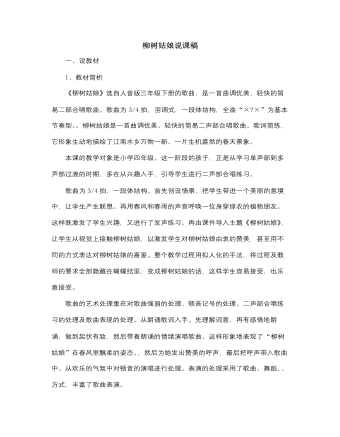
人音版小学音乐三年级下册柳树姑娘说课稿
设计意图:这是本课的重点内容。先让学生装扮风雨声赞美柳树,在这个过程中学会歌曲旋律.采用打击乐器或小手为歌曲伴奏,使学生更生动的表现歌曲的美感,丰富了审美体验。让学生在听、读、唱、动等情感体验活动中感受音乐、欣赏音乐和表现音乐。③学唱二声部设计意图:学生在学会歌曲后,欣赏录音注意二声部进入的位置,让学生先唱一声部,教师示范唱二声部.然后利用多种形式进行合唱练习。让学生感性认识音乐要素变化,在音乐中起到的作用,增加了知识性和趣味性,同时达到巩固歌曲的目的。6、律动表演,情感升华。在教学的尾声教师创设教学情景,启发学生植树,请两位同学模拟植树场景,其余的学生以他们为中心围成圆圈,用最好听的歌声和最优美的动作来祝福小树苗快快长高。设计意图:这是本课情感态度价值观目标的拓展。通过课堂上的植树活动,潜移默化地教育学生“爱护树木,关注环保”,从我做起,从现在做起。

